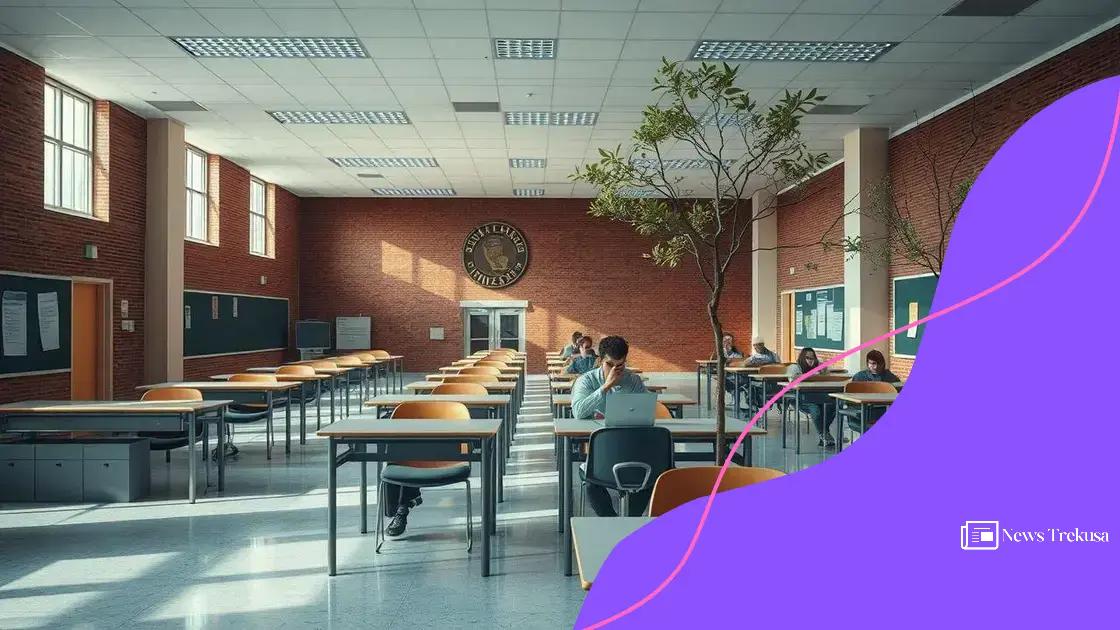Budget cuts hit colleges and universities: what’s next?

Budget cuts hit colleges and universities significantly impact student services, leading to larger class sizes and reduced resources, while students adapt through peer support networks and universities seek innovative funding solutions.
Budget cuts hit colleges and universities across the nation, creating ripples that affect both students and staff. Have you noticed how these cuts are reshaping higher education? Let’s dive into the consequences and explore potential paths forward.
Understanding the impact of budget cuts
Understanding the impact of budget cuts on colleges and universities is crucial to grasping the current educational climate. These cuts lead to significant changes that shape both academic offerings and the overall student experience.
In recent years, budget constraints have forced institutions to re-evaluate their priorities. Programs that once thrived may face reductions or even elimination, impacting the diversity and quality of educational options available to students.
Direct Consequences of Budget Cuts
These budget cuts can manifest in several ways that directly affect students and faculty members. For instance, colleges may need to:
- Increase tuition and fees, making education less affordable for students.
- Reduce course offerings, leading to fewer choices in major programs.
- Limit student services, affecting academic counseling and mental health support.
- Cut staff positions, which can lead to larger class sizes and less personalized attention for students.
The ripple effects of these decisions can lead to decreased enrollment, as prospective students may seek more stable and supportive environments elsewhere. This creates a cycle where reduced funding results in fewer students, leading to even more budget cuts.
The Broader Impact on Campus Life
Beyond academics, budget cuts also impact campus life and student engagement. Extracurricular activities, which are essential for personal development, might see drastic reductions. Students who might have been involved in clubs or sports could feel disconnected without those opportunities.
Moreover, colleges and universities might struggle to attract high-quality faculty if they cannot offer competitive salaries or funding for research. This, in turn, compromises the educational quality that students expect.
Thus, understanding the impact of budget cuts goes beyond financial numbers; it encompasses the overall experience and future opportunities for students across the board.
How universities respond to financial pressures
How universities respond to financial pressures is a crucial topic as many colleges face significant budget cuts. These pressures force institutions to rethink their strategies in order to maintain quality education while managing costs.
When financial difficulties arise, universities often implement various measures. For instance, they might consider increasing tuition fees, which directly impacts students and their families. This decision can lead to mixed reactions—while some argue it’s necessary for sustainability, others worry it makes college less accessible.
Strategic Budget Management
Another common response involves more efficient budget management. Many institutions conduct thorough reviews of their expenditures to identify areas where they can cut costs without sacrificing essential services. For example:
- Streamlining administrative operations to reduce overhead.
- Consolidating programs that have overlapping goals.
- Reducing energy consumption through sustainable practices.
- Leveraging technology to enhance operational efficiency.
Furthermore, universities may focus on securing alternative sources of funding. This can include increasing fundraising efforts or seeking grants from government and private organizations. Engaging alumni is also a key strategy, as many alumni want to give back to their alma mater.
Innovative Program Adjustments
Additionally, colleges often adjust their academic programs in response to financial strains. They may cut or combine less popular courses while expanding programs that attract more students. This not only helps with enrollment numbers but can also enhance the institution’s reputation.
Creating partnerships with local businesses and organizations for internships or job placements fosters stronger ties to the community. This strategy not only helps students gain practical experience but can also lead to potential sponsorship or funding opportunities for the university.
Finally, universities are increasingly investing in online education. Adapting to this trend can lower operational costs while providing flexibility for students, helping them to advance their education in more convenient ways.
Innovative solutions for educational funding

Innovative solutions for educational funding are essential as colleges face ongoing financial challenges. With traditional funding sources dwindling, universities are exploring new avenues to ensure they can continue to provide quality education.
One of the most promising approaches is the expansion of public-private partnerships. These partnerships allow universities to collaborate with businesses and local governments. By pooling resources, they can enhance educational programs and provide students with unique opportunities that would otherwise be unavailable.
Utilizing Technology for Fundraising
Advancements in technology also play a crucial role in modern fundraising strategies. Online platforms make it easier for institutions to reach potential donors across the globe. For example:
- Social media campaigns invite alumni and supporters to contribute.
- Crowdfunding allows students and departments to raise money for specific projects.
- Virtual fundraising events create a sense of community while generating funds.
- Email campaigns provide updates and call for donations in engaging ways.
Moreover, universities are beginning to offer tuition payment plans that make education more affordable. By allowing students to pay their tuition fees in installments, more families can manage their financial obligations without compromising their educational aspirations.
Scholarship Innovations and Grants
Another significant area where innovation is happening is in scholarships and grant funding. Many institutions are creating targeted scholarships to support underrepresented groups in higher education. This not only helps increase diversity but also attracts a broader range of applicants.
Additionally, new grant opportunities are often tied to specific research initiatives or community engagement projects. Universities are finding ways to align their funding applications with current social issues, thus increasing their chances of approval.
As universities adapt to changing financial landscapes, the focus on innovative solutions for educational funding continues to grow. These methods not only help to bridge budget gaps but also enhance the educational experience for all students.
The future of college affordability
The future of college affordability is a pressing concern for students, parents, and educational institutions alike. As tuition costs continue to rise, it is essential to explore what lies ahead in making higher education more accessible.
One of the potential solutions is the introduction of income-driven repayment plans. These plans allow graduates to pay back their loans based on their income, making repayments more manageable. This approach ensures that students do not have to choose between financial stability and their educational goals.
State and Federal Initiatives
Governments are also playing a crucial role in shaping the future of college affordability. By increasing funding for public universities, states can help keep tuition rates stable. An example of this is:
- Offer grants that cover tuition for low-income students.
- Subsidize community college programs, encouraging more students to pursue higher education.
- Launch awareness campaigns about financial aid options available.
- Support legislation aimed at capping tuition hikes.
Moreover, transparency in pricing can help students make informed decisions about their education. When colleges clearly show the total cost of attendance, potential students can better plan their finances.
Innovative Learning Models
In addition to financial strategies, innovative learning models are emerging. For example, universities are increasingly adopting hybrid models that combine in-person and online learning. This flexibility not only caters to different learning styles but also reduces costs associated with campus facilities.
Another approach is competency-based education, where students progress by demonstrating their knowledge rather than adhering to a strict semester timeline. This can lead to faster graduation rates and lower overall costs, as students can complete their degrees at their own pace.
Ultimately, the future of college affordability relies on a combination of government action, institutional responsibility, and innovative educational practices. By working together, stakeholders can help ensure that higher education remains within reach for all students.
Student experiences amidst budget constraints
Student experiences amidst budget constraints are becoming increasingly challenging in today’s educational landscape. As colleges implement budget cuts, many students find themselves navigating a more limited environment.
With reduced funds, universities often cut back on important services and resources. This can lead to larger class sizes, fewer available courses, and a general feeling of being unsupported during their studies. Students may find it difficult to connect with advisors or receive personalized help as staff members are stretched thin.
Changes in Campus Life
The overall college experience is also impacted. Extracurricular activities, which play a crucial role in student engagement and personal growth, often suffer as budgets tighten. For instance:
- Clubs may have less funding for events and activities.
- Sports teams might face cutbacks in equipment and travel allocations.
- Events that foster community, like guest lectures and cultural nights, may be canceled or scaled back.
- Some students report feeling more isolated as these social opportunities diminish.
Moreover, many students are forced to take on part-time jobs to help cover their increasing expenses, leaving them with less time for their studies and personal development.
Adapting to New Realities
Despite these challenges, students are adapting in various ways. Many are becoming more resourceful in seeking out alternative resources, such as online study materials and free community workshops. Additionally, peer support networks are growing stronger as students lean on each other for academic assistance and emotional support.
Some institutions are responding to student needs by creating new support services, such as mental health resources and financial literacy programs. These initiatives aim to provide students with the tools they need to thrive, even in tough financial times.
Overall, the experiences of students amidst budget constraints reflect a complex interplay of challenges and adaptations, shaping their college journey in profound ways.
FAQ – Frequently Asked Questions about Student Experiences Amidst Budget Cuts
How are budget cuts affecting student resources?
Budget cuts lead to fewer available courses, larger class sizes, and reduced support services, making it harder for students to get the help they need.
What initiatives are universities implementing to support students?
Many universities are creating new support services and enhancing existing ones, such as mental health resources and financial literacy programs.
How are students coping with the reduced campus activities?
Students have become resourceful, forming peer networks and seeking online resources to maintain academic and social engagement.
What can be done to improve college affordability?
Implementing income-driven repayment plans, increasing government funding, and fostering public-private partnerships are some strategies that can help enhance affordability.
SEE MORE CONTENT
